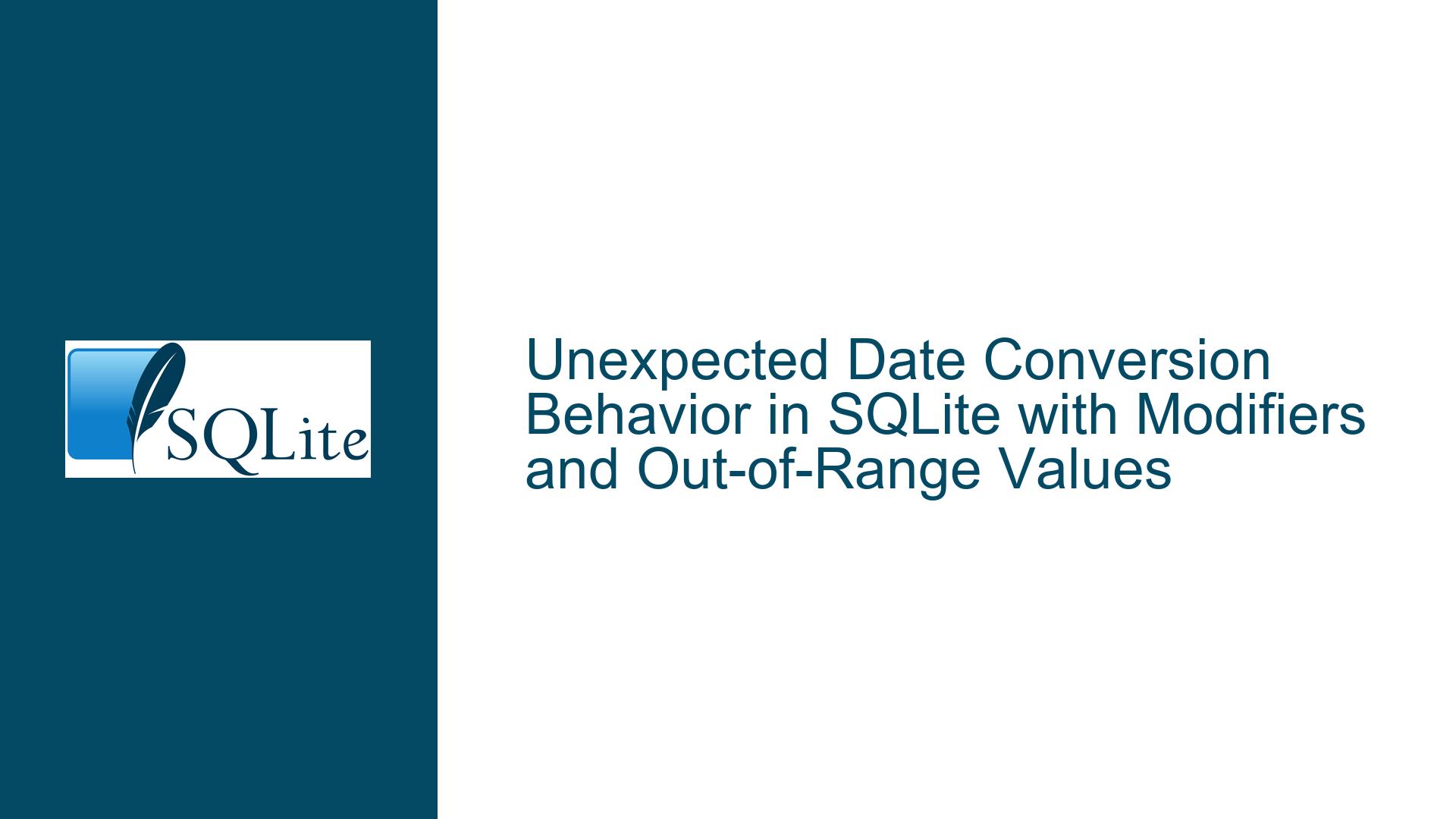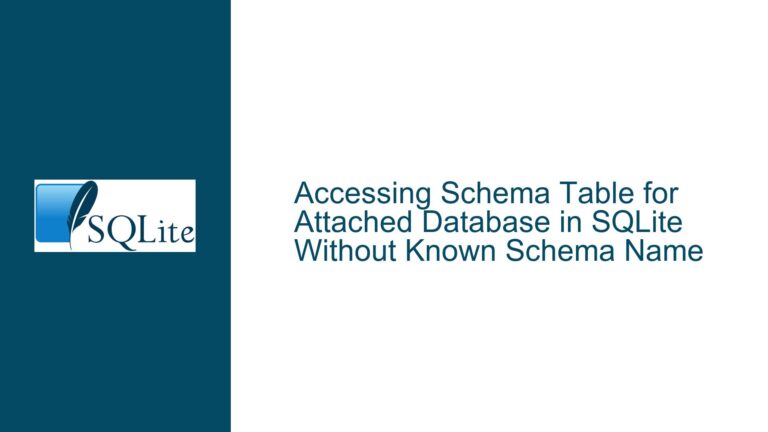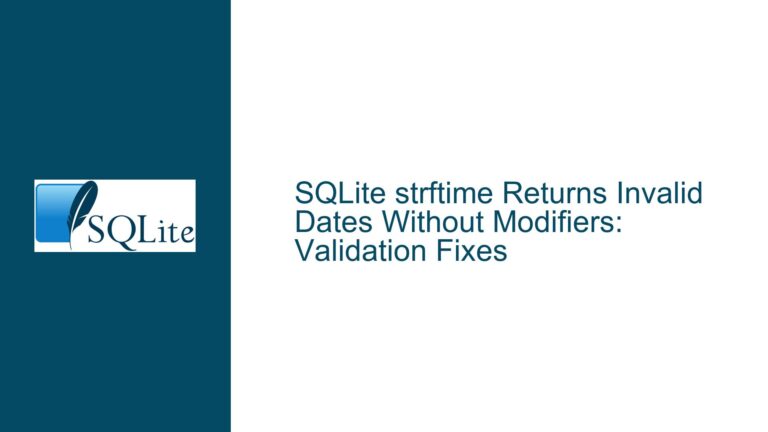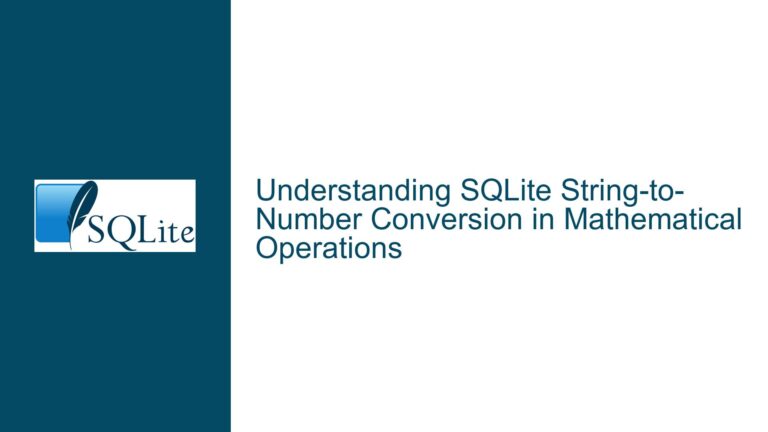Unexpected Date Conversion Behavior in SQLite with Modifiers and Out-of-Range Values
Valid Date Ranges, Modifier Effects, and Silent Failures in SQLite Date/Time Functions
Understanding SQLite’s Date Handling Boundaries and Modifier Interactions
SQLite’s date and time functions are designed to operate within a specific range of valid dates, and their behavior outside this range—especially when modifiers like 'localtime' or 'utc' are applied—can lead to counterintuitive results. This guide dissects why large numeric inputs combined with timezone modifiers produce unexpected default dates (e.g., 2000-01-01 or Julian day 0.0) instead of errors or NULL values. We explore the technical foundations of SQLite’s date parsing, the role of modifiers in forcing implicit conversions, and strategies to prevent silent failures when working with edge-case timestamps.
Core Constraints of SQLite Date/Time Functions and Modifier-Driven Conversions
SQLite’s strftime(), julianday(), and related functions operate on Julian day numbers, which represent dates as fractional days since a predefined epoch. The valid range for these functions is 1721059.5 to 5373484.5 in Julian day terms, corresponding to dates between 0000-01-01 00:00:00 and 9999-12-31 23:59:59. Inputs outside this range yield undefined behavior, but the presence of modifiers like 'localtime' or 'utc' alters how invalid inputs are processed.
When a modifier is applied, SQLite attempts to adjust the timestamp by converting it to the specified timezone. This process involves parsing the input value into an internal date/time representation before applying the modifier. For out-of-range values, this parsing fails silently, defaulting to a "fallback" timestamp (e.g., 2000-01-01). Without modifiers, invalid inputs may return NULL or empty results, as no implicit conversion is forced. This discrepancy explains why strftime('%Y-%m-%d', 999999999.0) returns nothing, while the same function with 'localtime' produces 2000-01-01.
Root Causes of Undefined Date Conversions and Modifier-Induced Defaults
Out-of-Range Julian Day Numbers
Numeric values like999999999.0far exceed the maximum valid Julian day (~5373484.5). SQLite’s date functions do not enforce input validation by default, treating such values as "garbage in, garbage out" (GIGO). The internal parsing logic for dates clamps or resets invalid values to a default when modifiers force a conversion, but leaves them undefined otherwise.Modifiers Forcing Implicit Date Normalization
Modifiers like'localtime'or'utc'trigger a timezone adjustment, which requires SQLite to interpret the input as a valid timestamp. If the input is outside the acceptable range, the parser fails to compute a meaningful adjustment and defaults to a "zero" state—often2000-01-01or Julian day0.0. This behavior is an artifact of SQLite’s lightweight error handling, which prioritizes performance over rigorous validation.Inconsistent Error Signaling Across Function Variants
Functions likejulianday()return0.0for invalid inputs when modifiers are present but return NULL when modifiers are omitted. This inconsistency stems from differences in code paths: modifiers invoke additional parsing steps that mask failures by substituting defaults, whereas unmodified calls abort early and return no value.Ambiguity in Floating-Point Timestamp Handling
SQLite accepts integer and floating-point numbers as Unix timestamps (seconds since 1970-01-01) or Julian days, depending on context. Extremely large values (e.g.,999999999.0) are misinterpreted as Unix timestamps, leading to nonsensical date conversions. For example,999999999.0as a Unix timestamp corresponds to 2001-09-09 01:46:39, but when treated as a Julian day, it is invalid, causing further confusion.
Resolving Silent Date Failures: Validation, Alternatives, and Defensive Coding
Step 1: Enforce Input Validation Before Date Conversion
Validate numeric inputs against SQLite’s date boundaries before passing them to date functions. Use a helper query to check if a value is within the valid Julian day range:
SELECT
CASE
WHEN :input >= 1721059.5 AND :input <= 5373484.5 THEN
strftime('%Y-%m-%d', :input, 'localtime')
ELSE
'Invalid date'
END;
For Unix timestamps, ensure values correspond to reasonable dates. The maximum 64-bit Unix timestamp (approximately 292 billion years in the future) is far beyond SQLite’s capabilities, so clamp inputs to a practical range (e.g., 0 to 253402300799, representing 9999-12-31 23:59:59).
Step 2: Avoid Reliance on Modifiers for Implicit Validation
Modifiers like 'localtime' do not validate inputs—they merely adjust valid timestamps. To detect invalid dates, explicitly check the result of julianday() without modifiers:
SELECT
CASE
WHEN julianday(:input) IS NULL THEN 'Invalid date'
ELSE strftime('%Y-%m-%d', :input, 'localtime')
END;
Step 3: Use Epoch Conversion for Unix Timestamps
When working with Unix timestamps, explicitly convert them using 'unixepoch' modifier to avoid ambiguity:
SELECT strftime('%Y-%m-%d', :timestamp, 'unixepoch', 'localtime');
This ensures SQLite interprets the input as seconds since 1970-01-01, not Julian days. For subsecond precision, use 'auto' modifier (SQLite 3.38.0+):
SELECT strftime('%Y-%m-%d-%H:%M:%f', :timestamp, 'auto', 'localtime');
Step 4: Handle Timezone Conversions Manually
Instead of relying on 'localtime' or 'utc', compute timezone offsets explicitly to retain control over invalid states:
-- Convert UTC to localtime (e.g., UTC+8)
SELECT strftime(
'%Y-%m-%d-%H:%M:%f',
julianday(:input, 'utc') + 8/24.0
);
This approach bypasses modifier-induced defaults and allows custom handling of invalid inputs.
Step 5: Implement Defensive Wrapper Functions
Create user-defined SQL functions (UDFs) in your application layer to validate dates before calling SQLite’s built-in functions. For example, in Python:
def safe_strftime(conn, timestamp):
cursor = conn.execute("SELECT julianday(?)", (timestamp,))
jd = cursor.fetchone()[0]
if jd is None or jd < 1721059.5 or jd > 5373484.5:
return None
cursor = conn.execute("SELECT strftime('%Y-%m-%d', ?)", (jd,))
return cursor.fetchone()[0]
Step 6: Log and Audit Invalid Date Attempts
Add triggers to log invalid date inputs into a dedicated table for analysis:
CREATE TABLE date_errors (
invalid_input REAL,
context TEXT,
timestamp TEXT DEFAULT (datetime('now'))
);
CREATE TRIGGER validate_dates_before_conversion
BEFORE INSERT ON events
WHEN julianday(NEW.date_input) IS NULL OR
julianday(NEW.date_input) NOT BETWEEN 1721059.5 AND 5373484.5
BEGIN
INSERT INTO date_errors (invalid_input, context)
VALUES (NEW.date_input, 'Attempted invalid date insertion');
SELECT RAISE(ABORT, 'Invalid date');
END;
Step 7: Leverage Type Affinity and CHECK Constraints
Use strict typing and schema constraints to reject invalid dates at insertion:
CREATE TABLE events (
event_date TEXT CHECK (
event_date IS strftime('%Y-%m-%d', event_date) AND
julianday(event_date) BETWEEN 1721059.5 AND 5373484.5
)
);
This ensures only properly formatted and valid dates are stored.
Step 8: Educate Developers on SQLite’s Date Handling Philosophy
SQLite prioritizes flexibility and performance over rigorous input validation. Developers must adopt a defensive coding mindset, treating all external inputs as potentially invalid. Incorporate date validation into data pipelines, API boundaries, and UI layers to prevent invalid dates from reaching the database.
By understanding SQLite’s constraints, enforcing pre-validation, and adopting defensive coding practices, developers can avoid silent date conversion errors and ensure reliable handling of temporal data. The key takeaway is that SQLite’s date functions are tools, not guardians—responsibility for input integrity lies with the developer.






